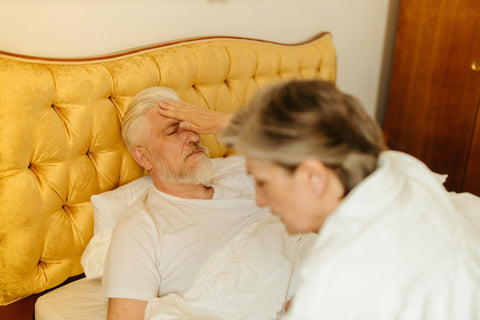When it comes to fever, there is a lot of confusion about when to go to the hospital. Some people think that any fever warrants a trip to the ER, while others only go if their fever reaches a certain level. So what's the right answer? Truth is that there is no definitive answer to this question. It depends on your individual situation and on the severity of your fever. However, Arklinen Store is here to give you some general guidelines you can follow in order to make the best decision for yourself.

A fever can occur when the body temperature rises over the typical temperature of around 98 degrees. Doctors won't be able to identify you as having a fever if the temperature of your body increases to 100.4 degrees or greater. The temperature rise typically indicates the body is fighting something or an infection.
If you are experiencing a fever, it is important to seek medical attention right away. This is especially true if your fever is accompanied by other symptoms, such as chills, body aches, or trouble breathing. In addition, Arklinen Store manufactures different types of cotton sheets that can surely aid you in times of having a fever to help you feel comfortable and warm. Shop with us now!
What is a Fever?

In most adults, the average body temperature falls between 97degF and 99degF. However, 98.6degF is usually considered normal. If a patient's temperature rises to 100.4degF or greater, the patient is likely suffering from a fever.
A fever is a condition in which the body's normal temperature increases above its normal range, typically due to an infection or illness. Some of the most common causes of a fever include viruses, bacteria, and other pathogens that can attack the immune system.
The reaction of the body
When your body detects an invader, it will try to fight it off by increasing your core temperature. This helps kill the pathogen and also makes you more uncomfortable, which can act as a motivating factor to rest and recover.
Symptoms of fever typically include feeling hot or sweaty, chills, muscle aches, fatigue, and loss of appetite. If your fever is high enough or lasts long enough, it can cause serious complications such as dehydration or organ damage.
If you suspect that you have a fever, it's important to consult with your doctor right away for proper treatment. There are several methods for treating fevers at home, including taking over-the-counter medications and drinking plenty of fluids. But if your fever is very high or persistent, you may need to seek medical care for more aggressive treatment options.
Body Language for fever
A fever is a sign that the body is fighting off an infection, and it's important to keep track of your feverish child's temperature to make sure it doesn't get too high. You can help keep your child's fever under control by using comfortable cover sheets and thin blankets and keeping a stack of Arklinen Store’s luxury towels nearby to cool them down if they start to feel hot.
When you have a fever, it's important to make sure you're taking care of yourself. One way to do that is by keeping your bedroom and bathroom as clean as possible. That means changing your sheets and towels often and using kitchen cloths instead of bathroom towels. Having clean sheets and towels will help you feel more comfortable and keep your fever under control.
How Can I Tell the Common Signs of Fever?

The cause of your fever is determined by the factors that cause you to feel sick, and typical symptoms can include the following:
- The temperature of the body at 100.4 degrees or more
- Shivers
- Sweaters
- Dehydration
- Weakness
- A loss of appetite
- Achy muscles
The symptoms experienced are considered normal, not dangerous, and treatable at home using plenty of water, rest, prescription medication, and whatever you can do to stay calm and reduce your body's temperature.
The fever should decrease within three to seven days. If this differs from the case, you could have an underlying problem that requires attention. The best method to determine when you should seek urgent care for a fever is to track your temperature, manifestations, and duration of your rage.
towels, washcloths, or cloth towels a cold compress on various areas of your body where the fever may be causing discomfort. Simply soak it in the water and then wring it out slightly so it will not drip on the floor. You can then apply this cold compress directly to your forehead, chest, neck, or another area as needed.
How Long Will an Illness Last?

The length of an illness can vary widely depending on a number of factors, such as the severity and type of illness, as well as an individual's age, overall health status, and other lifestyle factors. In general, illnesses tend to last anywhere from a few days to several weeks or even months. For example, common colds and the flu typically only last for a week or two at most, while more serious conditions like pneumonia may take longer to resolve.
Additionally, some illnesses are more likely to recur over time than others; for instance, some people may experience frequent bouts of back pain that seem to come and go with little rhyme or reason. While there is no way to predict exactly how long an illness will last, there are steps that you can take to minimize its impact and speed up your recovery. For example, it is important to get plenty of rest and stay hydrated by drinking lots of fluids.
Therapies for illness
You may also want to consider using over-the-counter medications or alternative therapies, like acupuncture or massage, to help relieve symptoms and manage pain. Additionally, staying physically active and maintaining a healthy diet can also help you bounce back more quickly from an illness.
Make you have a breathable comforter to help keep you warm and cozy while you sleep. These can help ease the symptoms of fever by keeping your body temperature regulated. Also, consider using a full mattress pad or 200-thread count soft duvet cover. These products are made from materials that promote thermal regulation and wick away moisture from your skin, helping to keep you cool and comfortable even when your fever is rising.
What is the Ideal Moment to Visit the Hospital With a Fever?
Fever is a common symptom of many different illnesses, including infections, cancer, or autoimmune disorders. If you are experiencing fever symptoms and are not sure whether you need to go to the hospital, it is important to be aware of when you should seek medical attention. Generally speaking, it is best to visit the hospital as soon as possible if your fever reaches above 100 degrees F. This is especially true for infants and young children, who can experience fever-related complications at lower temperatures than adults.
Other fever-related signs that may indicate that you should head to the hospital include difficulty breathing or swallowing, severe headache or body aches, confusion or disorientation, seizures or convulsions, skin rash or blisters, or fever that lasts for more than five days. If you are worried about fever symptoms, it is always best to err on the side of caution and seek medical attention as soon as possible.
How serious is a fever can be?
A fever can be an indication of a potentially serious underlying condition, so it is important to get diagnosed and treated as quickly as possible. If you are experiencing any fever-related symptoms, do not hesitate to visit your local hospital or talk to your doctor for guidance and advice.
Bath towel sheets, towel bath robe, and bath sheet towel are an important part of your fever-reducing arsenal. These materials can be used in a variety of ways to help you cool down and stay comfortable when you're dealing with fever symptoms. Perhaps the most obvious use for these materials is simply as a way to keep yourself dry and warm when you are feeling hot and feverish. They provide a soft absorbent surface that wicks away moisture from your skin, helping to keep you comfortable and cool as you rest or sleep.
Fever approach for babies
It is treated differently in infants and children as compared to adults. In the case of infants, particularly those three months and older, the presence of fevers can be concerning because they have undeveloped immune systems. Therefore, medical professionals will quickly intervene whenever a very young baby suffers from a fever.
There are many methods to measure temperature. The most precise process is to use a rectal measurement. The majority of medical guidelines about fever are based on rectal temperatures.
If your infant (newborn up to three months) is suffering from a fever, there are a few reasons to have them taken to the ER:
- Temperature A high or low temperature is alarming. If your child has a rectal temperature above 100.4 or below 97, it is recommended to bring them into the ER. It is also a sign that the baby's skin is cold to the skin, regardless of the temperature.
- Insufficient feeding: Newborns generally have a feeding interval of 2 to 3 hours. As the baby's stomach expands and expands, it'll be able to take in more food and might eat less frequently. Get medical attention if your baby shows an ongoing decrease in the frequency with which they're eating (for more than three meals) and if the child isn't awake to feed.
- Wet diapers are less frequent and are often found with poor feeding. Most infants will have a wet diaper at each feeding, usually every 3-4 hours. Note if your child notices a constant reduction in the number of wet diapers (or that the diapers are drier) or haven't had a diaper that has been wet for longer than four hours. This could be a sign the child may be getting dehydrated.
- Trouble breathing: This could mean the sound of breathing that is loud or constricted. It could also mean that your child appears to be struggling to breathe more. It's possible to notice their ribs more prominently as they live, or they have to take regular breaks while feeding to breathe.
- Lips that are blue in color or skin: This may indicate low levels of oxygen that can result from respiratory infections and severe non-respiratory illnesses.
- Green vomit: This could occasionally suggest that something is more potent within the abdomen.
- Arousal levels or activity changes. The baby may sleep often. If you notice that your baby is less able to wake up or appears less energetic or active, This could indicate worry.
- Rash: A physician must be able to evaluate any new or sudden eruption.
In case you’re looking for a pillowcase that is soft on your skin, Arklinen Store offers our satin stripe fabric oxford pillowcase which is the best fabric to sleep on out there in the market. We also have kitchen cloths like ark glass cloth and ark oven cloth that can be utilized to clean your glassware and protect your hands from burning while handling hot utensils and silverware.
Children fever
Children often contract and develop infections that trigger fevers, particularly when they begin attending school care and schools. Fortunately, their immune systems are much more robust when they reach this age. Many of these childhood diseases will heal within a few days by themselves.
However, there are reasons to visit the hospital if infants, toddlers, and young children suffer from fever. The reasons for this are similar to the explanations given to babies; however, there are some differences:
- It is important to note that the threshold for temperature is slightly higher in the older kids, and there's no need to visit the ER for this number by itself -- unless the temperature is above 100.
- Dehydration: As with infants, be aware that your child is experiencing an abrupt decline in eating and drinking or when you notice a dramatic decrease in urination frequency.
- Trouble breathing or a blue hue to the lips or skin A sign of more severe illness includes loud breathing, wheezing, and increased breathing workload. You'll often notice this when they're using additional muscles to breathe, for example, the muscles above your collar bones in between their ribs and abdominal muscles.
- The difficulty of waking up is that children follow a routine as they age. Children usually wake up and sleep each day simultaneously. Take them to the ER when you notice that your child is sleeping more than expected, especially in a way that is different from their usual routine.
- Stiff neck at any age should you observe that your child isn't able to bend their neck to look up or down, then make sure you visit the hospital emergency rooms as fast as you can. It could be a sign of meningitis.
- Certain rashes: Various viruses commonly found in children cause harmless itchy rashes. However, examples of more severe rashes are those that develop large blisters placed on your feet or your palms that seem like a target or bullseye or are small spots of red or purplish that look like tiny bruising beneath the skin (also known as "petechiae").
In case you’re looking for a much more comfortable king bed sheets set, Arklinen Store offers you our Super King Sheet with a thread count of 200 that will surely help you feel cozy even in times of having a fever. Check out also our Super King luxury duvet cover that is much softer on your skin and the best cotton duvet out there in the market.
Adults fever
Adults typically have lower fevers than children, and their temperatures don't naturally rise as high. Adults are also more likely to have a more accurate awareness of when an illness is serious, and therefore fevers aren't triggering alarms as often as they do for children. However, there are instances for adults where a fever could indicate an infection requiring immediate medical care.
It is recommended to see your doctor or visit an emergency room if you're suffering from an illness that is accompanied by any indicators listed below:
- Neck stiffness or severe headaches Headaches that are mild are typical when you're sick. However, suppose your headache is more intense, or you're experiencing neck stiffness that is significant (exceptionally when you touch your chin with your chest). In that case, This may be an indication of meningitis. And this condition could be severe.
- Breathing problems: Most adults know what a typical cold respiratory illness is like. However, breathing difficulties or shortness of breath could alter your oxygen levels. This is especially true if your fingernails or lips appear gray or blue.
- Pain in the severe abdomen: Some abdominal infections, such as appendicitis or diverticulitis, require treatment with specific antibiotics or surgical intervention.
- Rashes: A new skin rash and fever combination is rare for adults than children. Although the majority of causes of rashes don't pose a risk, a few require medical care. And even if the inflammation is caused by a simple skin problem you can manage at home, some skin diseases also require treatment at the hospital.
- The symptoms of lethargy, confusion, or confusion: Older adults are at a greater risk of developing infections that could damage their entire body (sepsis) or lead to severe dehydration and organ failure. The first symptoms include erratic behavior, fatigue, or slight confusion.
- Difficulty or weakness It's best to get examined if you feel extremely weak, dizzy while standing or sitting, or unable to get up.
If you’re struggling to find the best bath cotton towels in the market, Arklinen Store presents you with our Supreme Bath Towel. This is a 450gsm towel that is surely delicate in your skin and extremely durable in that it can withstand commercial washing. Our supreme towels are the best plush bath towels out there in the market.
Conclusion
Fever is the body's way of fighting off infections and inflammation and generally does not indicate anxiety for adults. However, a temperature of more than 103 F (39.4 C) or more or a persistent fever for longer than two days could suggest a serious health issue and warrant medical attention. Adults should seek medical care when the fever is associated with other signs (listed above).
If a child or a baby is in that experience, a slight rise in temperature needs to be assessed. It is important to note that a prolonged low-grade fever is typically an indication the body's defense is working to fight an infection or a different health problem that is causing.
Doctors who are board-certified in the emergency department can take a complete health background, conduct an extensive physical exam, measure vital signs, and request laboratory tests to identify the root of your fever. Based on the condition which is the cause, they will manage your fever effectively by administering antibiotics and other medicines as well as fluids and rest.
Furthermore, it is also necessary to know the importance of the sheets that you are utilizing while drying off your skin after taking a bath or the sheets that you will be sleeping on. Arklinen Store is a manufacturer that produces different types of sheets that are used by hotels, restaurants, and of course households. Arklinen Store manufactures king-size cotton sheets, California king duvet inserts, waffled bathrobes, hand towels, face cloth towels, tea towels, and different bathroom sheets.
Don’t miss out on the chance to elevate your bathroom, kitchen, and bed. By using Arklinen Store’s products, your household can feel like a hotel, restaurant, or even a spa. Shop now!

